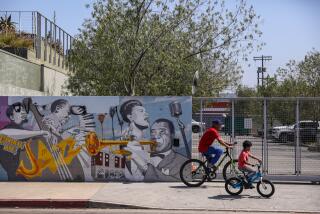Editorial: Whittier’s voting system shift is better for Latinos, but not ideal
Last year, the city of Whittier was sued under California’s Voting Rights Act. Roughly half of the city’s registered voters are Latino — yet, in its 116-year history, only one Latino has been elected to the five-member City Council. None have been elected in the last decade. According to the lawsuit, brought on behalf of several residents, power in Whittier has been concentrated in the hands of white politicians because of the city’s at-large voting system.
The problem with at-large systems is that they often dilute the voting power of minority groups, whose preferred candidates might be able to win if they ran in their own neighborhoods but who find it impossible to win over an absolute majority of voters citywide. At-large systems have been successfully challenged and ultimately dismantled in many California communities and in municipalities around the country.
In response to the lawsuit and complaints from Latino residents and activists, Whittier put a special ballot measure before voters this summer asking if they wanted to amend the city charter to switch to voting by geographic districts. The measure was approved, the lawsuit was dismissed, and this week the Whittier City Council moved to start the transition.
Now comes the hard part.
For one thing, the city isn’t completely changing to district elections. Under the current system in Whittier, voters choose five City Council members at-large. Each member takes a yearlong turn as mayor, a largely ceremonial post, in addition to carrying out his or her council duties. Under the new plan, voters will elect four council members, one from each of four geographic districts, to serve four-year terms. And a mayor will be separately elected at-large for a two-year term.
But the new mayor will just be a fifth council member with a new title. He or she will have no more power than the other members, and will vote with them as well.
Given that, it seems unlikely that the new election system will give Latinos a fair shot at voting in a majority and changing the long-standing balance of power. Even if the winning candidates for the four district seats reflect the demographics of the voting population — even if, say, two whites and two Latinos were elected — that would still leave one seat to be decided through an at-large system that is subject to the same racially polarized voting patterns that have long plagued Whittier.
The plaintiffs are seeking to have their lawsuit reinstated. In the meantime, the city is moving forward with its plans. Even the plaintiff’s attorney, Rod Pacheco, acknowledges that the new voting system is a step forward. The creation of five geographic districts would be ideal, but the creation of four will be better than what’s in place today.
The next challenge will be to draw the new district lines, which must be in place before the next round of municipal elections in April 2016. It certainly looks as though Whittier officials are doing a meticulous job of opening up the process to the public. They have scheduled “office hours” for residents and stakeholders to come in and talk to the city’s hired demographic experts about where the district lines should fall. (Residents can bring in their own proposed maps.) There will be community meetings and three public hearings. And the city has email-blasted details of these schedules to just about anyone whose email address they possess, including library card holders, PTA presidents, service organizations and the League of Women Voters.
That outreach will be crucial. Voter turnout in Whittier, in general, has been abysmally low. The percentage of registered voters who showed up for the last council elections in April as well as for the special ballot measure in June was in the teens. The lawsuit had also sought to have elections held in November to take advantage of higher turnout during election cycles that include state and national offices. But the ballot measure did not address that issue.
Ultimately, the City Council has the final say on the district maps. Its members should be scrupulously fair. And the plaintiffs, among others, should get involved and weigh in vigorously on the creation of the districts.
This is a process, and it’s not perfect, but the more people get involved, the better it will be.
Follow the Opinion section on Twitter @latimesopinion
More to Read
Start your day right
Sign up for Essential California for news, features and recommendations from the L.A. Times and beyond in your inbox six days a week.
You may occasionally receive promotional content from the Los Angeles Times.






